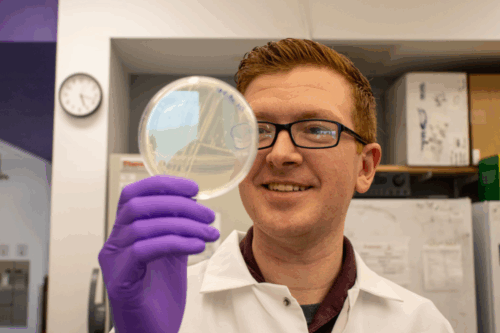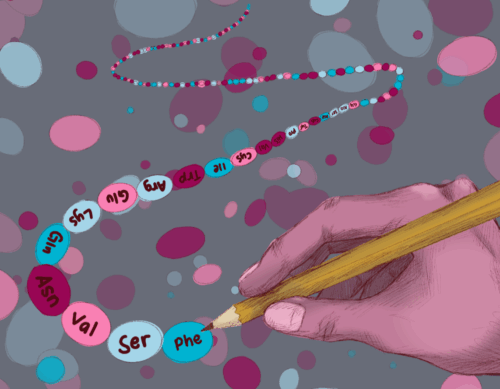Art by Melody Jiang. Photography by Emily Poag.
Proteins are the molecular machines of life, driving everything from the formation of memories to the division of cells. Each protein is assembled from a chain of building blocks called amino acids, strung together in a specific order dictated by a language shared by all living things: the genetic code.
Inscribed in DNA and translated through RNA, the genetic code is read in three-letter segments called codons, each composed of nucleotides—the basic units of genetic information. With just four kinds of nucleotide bases, the code yields sixty-four possible codons: sixty-one that specify the twenty standard amino acids and three that serve as stop codons, marking the ends of the protein chain. Long thought of as a standardized lexicon, the genetic code is now being reimagined. In a landmark study published in Nature, Yale researchers have fundamentally altered the genetic code by changing the function of two stop codons, in what they call a genomically “recoded” organism.
“The genetic code, long thought of as a fixed system, actually exhibits natural deviations,” said Farren Isaacs, a professor in Yale’s Department of Molecular, Cellular, and Developmental Biology and principal investigator of the study. “By engineering translation machinery, we can rewrite this fundamental language of life, expanding the biochemical capabilities of cells to produce novel proteins and synthetic chemistries.”
The Codon Connection
The genetic code is degenerate, meaning multiple codons can encode the same amino acid. This built-in redundancy adds a layer of protection against mutations—if one nucleotide changes, the codon might still code for the same amino acid, leaving the resulting protein unaffected. But this feature also offers an opportunity: because some codons are functionally interchangeable—either encoding the same amino acid or serving as stop signals—not all of them are strictly necessary. By reassigning these synonymous codons, researchers can incorporate new synthetic amino acids, expanding the genetic code and unlocking an endless library of novel proteins.
“The way I think about it is this: ribosomes are like protein printers, mRNAs are the recipes, and codons are the words. By changing what the words mean, we’re rewriting the language,” said Mike Grome (GSAS ʼ19), a postdoctoral researcher at Yale and the study’s first author.

Engineering the Impossible
There are three natural stop codons in the genetic code, written as UAA, UAG, and UGA to designate the codons they each contain. These short sequences act like punctuation marks, signaling the cell’s protein-making machinery to stop building a protein. Previous work by Isaacs tackled a crucial hurdle: systematically recoding 321 UAG codons to UAA and deleting Release Factor 1 (RF1)—the protein responsible for recognizing both UAG and UAA stop codons and ends protein synthesis by triggering the release of the finished protein. Removing RF1 was a necessary step to detach UAG from its original function so it could be repurposed within the genetic code.
In their latest study, the Isaacs Lab, in collaboration with the lab of Jesse Rinehart (MED ʼ04), associate professor in Yale’s Department of Cellular and Molecular Physiology, took this effort a step further by replacing 1,195 UGA codons with UAA. Together, these changes left UAA as the only functioning stop codon in a strain of Escherichia coli they dubbed “Ochre,” effectively freeing UAG and UGA for reassignment. This was more than a symbolic genome-editing feat—it was a foundational advance toward expanding the genetic code and reprogramming the cell’s translational machinery.
To accomplish this genome-wide recoding, the researchers used a two-phase engineering strategy: Multiplex Automated Genome Engineering (MAGE) and Conjugative Assembly Genome Engineering (CAGE). MAGE is a high-throughput technique for introducing many small, targeted edits to DNA while it is being copied, enabling broad codon replacement across the genome. CAGE complements this by leveraging bacterial conjugation—a natural process in which bacteria transfer genetic material through direct contact—to combine these edited DNA segments. One strain carrying an edited region transfers it to another through a pilus, allowing engineered parts to be combined in a stepwise fashion so different edited regions from separate strains are gradually merged into one. Through successive rounds, the team assembled a complete strain in which all native UGA (and previously UAG) codons had been replaced with UAA. The genetic code could still say “stop” with UAA, but now UGA and UAG were freed for new biological roles.
But codon replacement was only half the battle. “It’s not just about replacing a codon and expecting everything to fall into place,” Isaacs said. “The translation machinery is highly interconnected, and once you start modifying key elements, there are all these secondary effects. We had to account for those to make this work.”
tRNA Tinkering
A critical challenge was reengineering the molecular machinery that terminates translation. With all UAG codons removed, RF1 could be deleted without consequence—eliminating its recognition of UAG and UAA. This left only Release Factor 2 (RF2), which recognizes both UGA and UAA. In order to free up UGA for reassignment, the researchers had to reengineer RF2 so it would recognize only UAA, not UGA.
However, removing RF2’s recognition of UGA created an unexpected issue. A tRNA molecule responsible for inserting the amino acid tryptophan—which normally reads the codon UGG—began to misread for UGA as well. As a result, tryptophan was inserted at unintended sites, leading to errors in the resulting proteins. To prevent this, the team redesigned the tryptophan tRNA to restrict its recognition exclusively to UGG, eliminating unintended UGA decoding. This step was vital for safely converting UGA—a former stop signal—into a functional codon capable of encoding a new amino acid.
With UAG and UGA successfully reassigned, the team was able to incorporate noncanonical amino acids—synthetic or rare amino acids not typically found in nature. They achieved this by introducing orthogonal tRNA/synthetase pairs: custom molecular tools that operate independently from the cell’s native machinery. These orthogonal pairs specifically recognize the reassigned codons and install designer amino acids at defined locations, greatly expanding the chemical diversity of proteins beyond natural limits.
This two-tiered strategy—comprising genome-wide codon replacement and release factor/tRNA engineering—was essential to creating a genomically recoded organism. But it wasn’t plug-and-play: the team had to carefully adjust how codons were used, how different tRNAs competed for them, and how release factors responded to stop signals. Thanks to the team’s methodical approach, the final E. coli strain, “Ochre,” demonstrated robust growth and maintained accurate protein synthesis. This work builds on earlier efforts, including a project by the Isaacs Lab and the Church Lab at Harvard Medical School in which a UAG-lacking E. coli strain was engineered with increased resistance to a virus.
Beyond Stopping
The implications of the Ochre strain are profound. Freed codons can now encode noncanonical amino acids, allowing scientists to design biomolecules with properties beyond what is found in nature. Recoding also underpins genetic biocontainment strategies: by engineering organisms to depend on synthetic amino acids, they become incompatible with wild-type systems, reducing the chances of their surviving outside the lab and thereby minimizing ecological risks. Moreover, recoded organisms can be outfitted to resist viral infections, as many viruses rely on standard translation mechanisms.
Looking ahead, the project is advancing along several exciting paths. One major focus is on further engineering the recoded strain to more efficiently incorporate two distinct noncanonical amino acid chemistries into proteins. The team is actively refining both the cellular and translational machinery to improve yield and purity—key parameters for making this platform widely adoptable and impactful.
Beyond technical optimization, the Isaacs Lab is exploring how this new approach to protein synthesis—using two synthetic amino acids—can drive the design of entirely new biomaterials. Previous work has demonstrated the potential of incorporating a single noncanonical amino acid to build protein-based nanowires and programmable biologics—engineered proteins designed to carry out specific tasks in the body. With the new ability to “multifunctionalize” proteins, the lab is now investigating how to create programmable nanostructures—tiny, customizable shapes made of protein in two or three dimensions. By using different chemical groups at specific positions, they can control exactly how and where proteins link together. This could open doors to a new class of advanced biomaterials, including engineered hydrogels and other structural assemblies with tunable properties.
Another exciting direction involves extending these recoding technologies into new microbial and eukaryotic hosts to enhance genetic isolation. These efforts could create organisms resistant to viral infection and horizontal gene transfer, offering powerful tools for bio-applications in industrial, environmental, and therapeutic settings.
Together, these developments point toward a future where genomically recoded organisms serve as versatile platforms for both synthetic biology and safe, functional biotechnologies across multiple domains.
“Once you start opening up the genetic code,” Grome said. “The possibilities become endless—from novel therapeutics to entirely new biochemical pathways that don’t exist in nature.”

